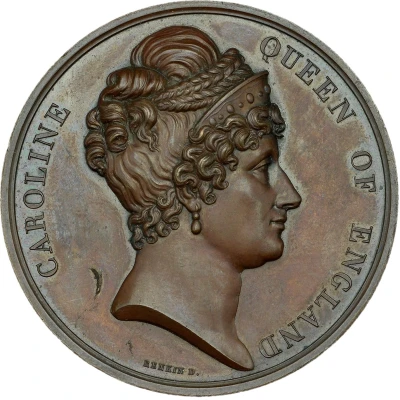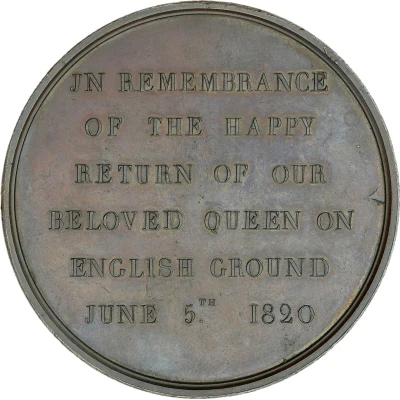


Medal - Queen Caroline of England Withdrawal of Pains & Penalties Bill,
1820 year| Pewter | 26.5 g | 43 mm |
| Location | United Kingdom (United Kingdom, British Overseas Territories and Crown Dependencies) |
|---|---|
| King | George IV (1820-1830) |
| Type | Medals › Commemorative medals |
| Year | 1820 |
| Composition | Pewter |
| Weight | 26.5 g |
| Diameter | 43 mm |
| Thickness | 2 mm |
| Shape | Round |
| Technique | Milled |
| Orientation | Medal alignment ↑↑ |
| Updated | 2024-11-14 |
| Numista | N#396662 |
|---|---|
| Rarity index | 97% |
Reverse
A palm tree rising in the centre, with waves crashing against rocks below and legend arching above. The year (1820) is given in Roman numerals at the bottom.
Script: Latin
Lettering:
I RISE BY MY DIFFICULTIES
MDCCCXX
Engraver: J. Westwood
Edge
Plain
Comment
The Pains & Penalties Bill was best represented in Sir George Hayter's painting ‘The Trial of Queen Caroline’, as George IV aimed to divorce his estranged wife through a Parliamentary bill proving she was unfaithful and annulling the marriage, despite having a daughter, Charlotte, together and him having numerous mistresses. The impetus was the death of his father, George III, in 1820, thereby making him king and Caroline queen, which George IV tried to prevent through this divorce bill. It passed in the House of Lords by a tiny minority of nine, so the government withdrew the bill before sending it to the House of Commons for debate. This medal commemorates the withdrawal of this bill and clearly supports Catherine, portraying her as triumphant with the laurel wreath and the legend of her rising through difficulties, and simply by naming her ‘Queen of England’ on the obverse.



